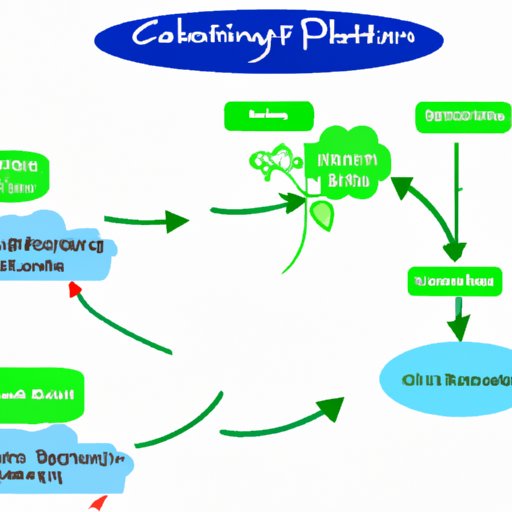Introduction
Photosynthesis is a process that occurs in plants and other organisms that use light energy to convert carbon dioxide and water into molecules that contain energy, such as sugars and starches. This process is essential for most life on Earth, as it is responsible for producing the oxygen needed for respiration and the food used for energy by plants and animals alike. In this article, we will explore the process of photosynthesis and its role in nature, as well as different types of photosynthesis and the components involved in the process.
Explaining the Process of Photosynthesis Step-by-Step
The process of photosynthesis can be broken down into two main steps: the light dependent reactions and the Calvin Cycle. During the light dependent reactions, light energy is captured and converted into chemical energy in the form of ATP (adenosine triphosphate) and NADPH (nicotinamide adenine dinucleotide phosphate). This energy is then used to convert carbon dioxide into organic molecules during the Calvin Cycle.
The light dependent reactions take place in the thylakoid membrane of the chloroplasts, which are organelles found in plant cells. During this stage, light energy is absorbed by pigments such as chlorophyll, which then generates a proton gradient across the thylakoid membrane. This proton gradient is used to generate ATP and NADPH, which are then used in the Calvin Cycle.
The Calvin Cycle takes place in the stroma, which is the liquid-filled space inside the chloroplast. During this stage, carbon dioxide is taken in and combined with the ATP and NADPH generated in the light dependent reactions. This process produces organic molecules such as glucose, which can be used for energy by the plant or stored as starch.

An Overview of Photosynthesis and Its Role in Nature
Photosynthesis plays an essential role in the natural world, as it is the process through which plants make their own food. This food is then eaten by other organisms, such as animals, fungi, and bacteria, to obtain energy. Additionally, photosynthesis is responsible for producing the oxygen needed for respiration. Without photosynthesis, life on Earth as we know it would not be possible.
In addition to producing food and oxygen, photosynthesis has a direct effect on the environment. According to a study published in the journal Science, “Photosynthesis is responsible for the cycling of water, carbon, and nitrogen, and is the primary source of oxygen in the atmosphere.” In other words, photosynthesis helps to regulate the climate and maintain the balance of gases in the atmosphere.
Examining the Different Types of Photosynthesis
There are three main types of photosynthesis: C3, C4, and CAM. C3 photosynthesis is the most common type of photosynthesis and is found in most plants. In this type of photosynthesis, carbon dioxide is directly incorporated into organic molecules. C4 photosynthesis is found in some grasses and shrubs, and is more efficient than C3 photosynthesis as it uses a special type of enzyme to break down carbon dioxide into a more usable form. Finally, CAM photosynthesis is found in succulents and cacti, and is a type of photosynthesis that allows these plants to survive in dry climates.

Breaking Down the Components of Photosynthesis
The process of photosynthesis requires four main components: carbon dioxide, water, chlorophyll, and light energy. Carbon dioxide is taken in from the environment and used to create organic molecules. Water is taken in through the roots and transported to the leaves, where it is used in the process. Chlorophyll is the pigment found in plants that absorbs light energy and converts it into chemical energy. Finally, sunlight or other light sources provide the energy needed to power the process.
Describing the Role of Chlorophyll in Photosynthesis
Chlorophyll is the green pigment found in plants that plays a key role in photosynthesis. Chlorophyll absorbs the light energy needed for photosynthesis and converts it into chemical energy. The chemical energy is then used to convert carbon dioxide and water into organic molecules such as glucose. Additionally, chlorophyll plays a role in the release of oxygen gas, as it helps to break down the water molecules used in the process.

Exploring the Benefits of Photosynthesis
Photosynthesis is essential for life on Earth, as it provides us with the food, oxygen, and energy needed to survive. Additionally, photosynthesis helps to regulate the climate by converting carbon dioxide into oxygen, which helps to reduce global warming. Furthermore, plants produced through photosynthesis are used in many industries, such as agriculture and forestry, and even have medicinal properties.
Investigating How Photosynthesis is Affected by the Environment
The process of photosynthesis is affected by several environmental factors. Temperature, carbon dioxide levels, and water availability all play a role in how efficiently photosynthesis occurs. For example, higher temperatures can increase the rate of photosynthesis, but too much heat can damage the plant. Similarly, higher levels of carbon dioxide can increase the rate of photosynthesis, but too much can lead to toxicity. Finally, water availability is important, as without enough water, the plant cannot carry out photosynthesis.
Conclusion
Photosynthesis is a vital process for life on Earth, as it is responsible for producing the oxygen and food needed for survival. This process involves the absorption of light energy and the conversion of carbon dioxide and water into organic molecules. There are three main types of photosynthesis, and these differ in terms of efficiency and the environment in which they occur. Additionally, photosynthesis has numerous benefits, including the regulation of the climate and the production of food and medicines. Finally, the process is affected by several environmental factors, such as temperature, carbon dioxide levels, and water availability.
(Note: Is this article not meeting your expectations? Do you have knowledge or insights to share? Unlock new opportunities and expand your reach by joining our authors team. Click Registration to join us and share your expertise with our readers.)
